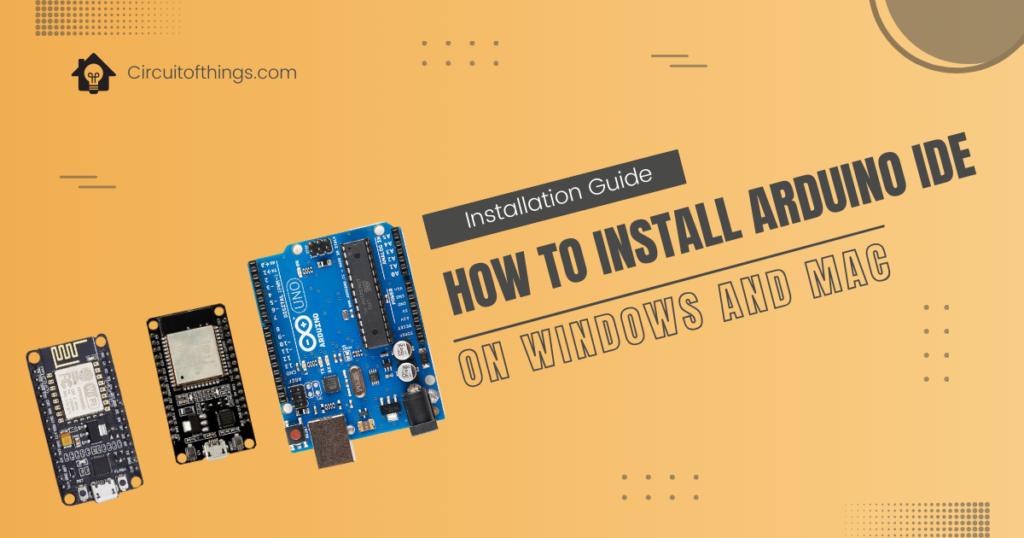The Arduino IDE is a vital tool for programming microcontrollers like Arduino boards, ESP32, and ESP8266. Whether you’re a hobbyist or a professional developer, learning to install and set up the Arduino IDE properly is crucial for a smooth development experience. This guide will walk you through installing the IDE on Windows and Mac, integrating ESP32 and ESP8266 boards, and installing the CH340 driver for compatibility with certain devices.
What is Arduino IDE?
The Arduino Integrated Development Environment (IDE) is an open-source platform that simplifies programming for microcontrollers. It provides a simple code editor and built-in tools to upload code to your hardware. With support for additional hardware like ESP32 and ESP8266, it extends its capabilities beyond Arduino boards.
Prerequisites for Arduino IDE Installation
Before diving into the installation, ensure you have the following:
- A computer running Windows or macOS.
- A stable internet connection for downloading software.
- USB cables to connect your microcontroller.
- Administrative access to your computer.
Downloading and Installing Arduino IDE on Windows
Step 1: Download the Arduino IDE
- Visit the official Arduino website.
- Choose the version compatible with your Windows system (Windows Installer or Windows ZIP file).
- Click “Download” and save the file.
Step 2: Install the IDE
- Open the downloaded installer file.
- Follow the prompts:
- Accept the license agreement.
- Select installation options (leave defaults checked).
- Choose the installation directory.
- Click Install to begin the process.
- Once installation is complete, click Finish.
Downloading and Installing Arduino IDE on Mac
Step 1: Download the Arduino IDE
- Go to the Arduino software page.
- Select the macOS version and click “Download.”
Step 2: Install the IDE
- Open the downloaded
.dmgfile. - Drag the Arduino icon into the Applications folder.
- Open the Applications folder, locate Arduino, and double-click to run it.
- Grant necessary permissions when prompted by macOS.
Integrating ESP32 with Arduino IDE
Adding ESP32 support requires installing additional board definitions in the Arduino IDE.
Step 1: Install ESP32 Board Manager
- Open Arduino IDE.
- Go to File > Preferences.
- In the Additional Boards Manager URLs field, paste this link:bashCopy code
https://raw.githubusercontent.com/espressif/arduino-esp32/gh-pages/package_esp32_index.json - Click OK to save.
Step 2: Add ESP32 Boards
- Go to Tools > Board > Boards Manager.
- Search for ESP32 in the Boards Manager.
- Click Install next to the ESP32 entry.
Step 3: Select Your ESP32 Board
- Connect your ESP32 to your computer via USB.
- Go to Tools > Board and select your ESP32 model.
- Ensure the correct COM port is selected under Tools > Port.
Integrating ESP8266 with Arduino IDE
The steps for ESP8266 integration are similar to ESP32.
Step 1: Install ESP8266 Board Manager
- Open File > Preferences in the Arduino IDE.
- Add the following URL to the Additional Boards Manager URLs:bashCopy code
http://arduino.esp8266.com/stable/package_esp8266com_index.json - Click OK to save changes.
Step 2: Add ESP8266 Boards
- Navigate to Tools > Board > Boards Manager.
- Search for ESP8266 and click Install.
Step 3: Select Your ESP8266 Board
- Connect your ESP8266 via USB.
- Under Tools > Board, choose your ESP8266 model.
- Confirm the correct COM port in Tools > Port.
Installing CH340 Driver for Windows
Many microcontrollers, like ESP32 or ESP8266, use a USB-to-Serial chip that requires the CH340 driver.
Step 1: Download the CH340 Driver
- Visit the official CH340 driver website or a trusted source like WCH.
- Download the appropriate driver for your Windows version.
Step 2: Install the CH340 Driver
- Run the downloaded
.exefile. - Follow the on-screen instructions to complete the installation.
- Restart your computer to finalize the setup.
Step 3: Verify Installation
- Connect your device to the PC.
- Open Device Manager.
- Look for a device named CH340 under Ports (COM & LPT).
Testing Your Setup
Once everything is installed:
- Open Arduino IDE.
- Write or load a basic example sketch (e.g., Blink).
- Select the correct board and port under the Tools menu.
- Click the Upload button to flash the code to your board.
- Confirm successful upload by observing the expected behavior on the board.
FAQs
What is the purpose of the CH340 driver?
The CH340 driver enables communication between your computer and microcontrollers using the CH340 USB-to-Serial chip.
Do I need the CH340 driver for macOS?
Most macOS systems include built-in support, but you may need to install it for older macOS versions.
Can I use Arduino IDE for both ESP32 and ESP8266?
Yes, the Arduino IDE supports both ESP32 and ESP8266 after adding the respective board descriptions.
Why is my ESP32 not detected?
Ensure the CH340 driver is installed and the correct COM port is selected in Arduino IDE.
Is Arduino IDE free to use?
Yes, Arduino IDE is open-source and free to download.
Can I install Arduino IDE on Linux?
Yes, Arduino IDE supports Linux distributions. The installation steps are available on the official Arduino website.
Conclusion
Following the right steps, setting up Arduino IDE on Windows and Mac, integrating ESP32 and ESP8266, and installing the CH340 driver is straightforward. With your tools ready, you can create exciting projects using Arduino and its extended hardware support. Start coding and bring your ideas to life!

1 Comment
Pingback: Build an ESP32 DHT11 Webserver for Real-Time Temperature and Humidity Monitoring - Circuit of Things